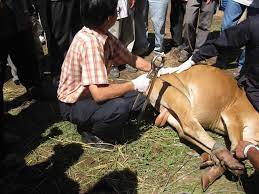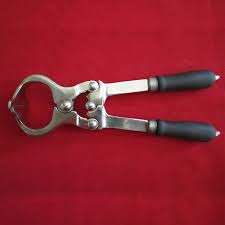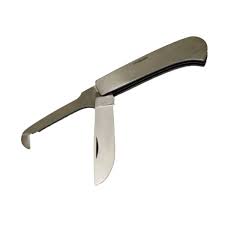Castration is an important management practice for sheep and goat farmers to maintain control of their breeding programs and successfully carry out breed improvement. Castration is the removal or destruction of the testes, epididymis, and a portion of each spermatic cord from a ram.
In most cases, non-breeding males and males not slaughtered at a young age should be castrated. Traditionally, farmers do not castrate animals, and both males and females are allowed to run together.
The result is that inferior males mate with females, passing on undesirable traits, and the young stock produced is not very productive. There are also other reasons for castrating sheep and goats.
Methods of Castration in Sheep and Goat

There are three commonly used methods of castration for sheep and goats: the Burdizzo method, the banding or elastrator method, and the knife (surgical) method. The different methods are more suitable for different sizes and ages of animals.
Examples of castration in animals include the elastrator method, which is more suitable for very young animals. It is good to match the castration method to the size and age of the animal.
1.The Burdizzo Emasculatome Method

The following step-wise procedures and figures show the castration of sheep and goats using the burdizzo.
Step 1. The animal should be properly restrained by the assistant. The operator grasps the scrotum in one hand and manipulates the testes down into the scrotum. He then locates the two spermatic cords between the fingers and pushes one cord over to one side of the scrotum. This is the first cord to be crushed.
Step 2. Place the jaws of the burdizzo onto the upper scrotum, leaving the rudimentary teats above the crushing point. Do not crush the septum or tissue between the testicles. Rather, do one side of the scrotum at a time.
Read Also: Cocoyam Nodes: Economic Importance, Uses, and By-Products
Step 3. Clamp the burdizzo over the cord on the side of the scrotum you are doing first. You can generally hear a clicking sound as the cord is crushed. Leave the instrument closed for 20 to 25 seconds or the time it takes to count from one to 25.
The spermatic cord is very elusive when you try to crush it. Be sure that you feel it within the jaws of the burdizzo before and after the jaws are closed. You can tug on the cord to see if it feels ruptured.
Step 4. Release the burdizzo, move it lower to a new site about 1 cm closer to the testicles and close it again to be doubly sure that the cord is crushed. A site below the first crush is chosen to minimize acute pain from a second crush.
Step 5. Locate the cord on the other side of the scrotum and position the burdizzo over it. Close the burdizzo and repeat what you did with the first cord.
Step 6. When you are done, you may see a mark on each side of the scrotum. The animal may be sore and move slowly for about a day. Be sure to encourage it to move around. At first, the scrotum will swell up a little, but the testicles will gradually shrink over the next few weeks, leaving a small scrotal sac.
2. The Banding or Elastrator Method

This method involves cutting off the blood supply to the testicles with a heavy-duty rubber band or ring. Materials needed include an elastrator and castrating bands. An elastrator is a special applicator that stretches a heavy-duty rubber band and applies it to the neck of the scrotum.
The scrotum and testes will fall off in two to four weeks, depending on the size of the testicles. This method causes some stress to the animal due to the pain and discomfort experienced by the constricting band, especially for 10 to 15 minutes after the elastrator band is applied. Follow these procedures to castrate lambs or kids using the elastrator method:
Procedure
Do not use rings older than 12 months to avoid breakage and to assure a tight fit. The rings must be strong enough to cut off blood flow in the arteries as well as the veins. If not, the scrotum will swell. Restrain the animal as described above. Place a rubber ring over the prongs of the elastrator.
Hold the elastrator with the prongs facing up. Close the handles to open the band. The scrotum and testicles are then passed through the expanded hole of the band. Position it as close to the animal’s body as possible, with care taken not to place the band over the rudimentary teats or involve the penis.
Release the elastrators, displacing the ring from the prongs, thereby positioning the band. The band will return to its original shape, cutting off circulation to the testicles and eventually causing all of the tissue below the band to die and fall off.
Check to be sure both testicles are still in the tip of the scrotum and that the ring is placed properly. If not, cut the ring with scissors and repeat the procedure.
Administer an injection of tetanus antitoxin. Even though this is a bloodless procedure, the tetanus organism can gain entry through the irritated tissue around the rubber ring. Check daily to be sure that the rubber band is still around the neck of the scrotum and for signs of infection.
Read Also: 16 Medicinal Health Benefits Of Lycium chinense (Chinese wolfberry)
3. The Knife Method

The testicles may be surgically removed. Materials needed include a clean and sterile sharp knife, a one-sided razor blade or scalpel, warm water, disinfectant (iodine can be used), syringes, tetanus antitoxin, and a fly control spray designed to be sprayed on open wounds. Bucks and rams older than 6 months may need to be sedated prior to castration using a knife.
To perform a knife castration, follow these procedures after the animal is restrained by the assistant:
Begin by washing your hands and instruments (knife or scalpel) thoroughly with soap and water and then disinfectant. Next, wash the scrotum thoroughly and disinfect it. Do not excite the lambs, kids or calves before or immediately after castration. This will increase bleeding.
Push the testicles high up into the scrotum. Cut off the bottom one-third of the scrotal sac with a cut parallel to the ground. The testes should now be visible. Manipulate each testis separately to the open end of the scrotum. It may sometimes be necessary to push on the abdomen if a testicle has been pulled deep into the abdomen.
Read Also: Where to Recycle Waste: A Guide to Responsible Recycling

